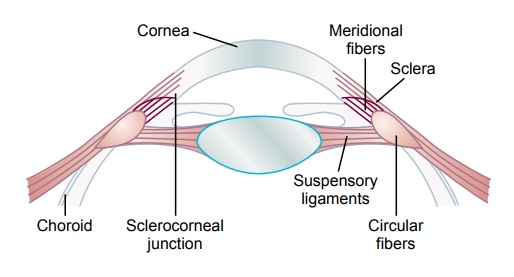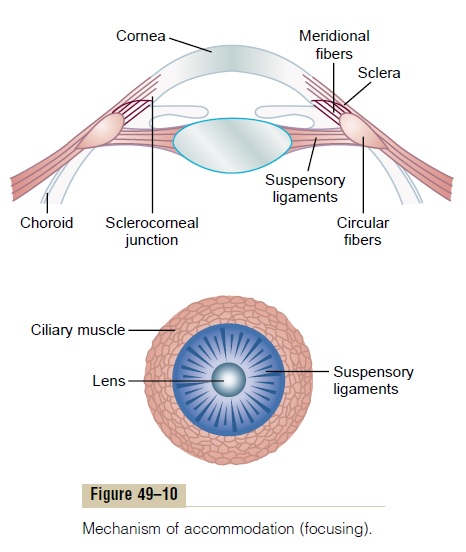Chapter: Medical Physiology: The Eye: I. Optics of Vision
Mechanism of ÔÇťAccommodationÔÇŁ - Optics of the Eye

Mechanism of ÔÇťAccommodationÔÇŁ
In children, the refractive power of the lens of the eye can be increased voluntarily from 20 diopters to about 34 diopters; this in an ÔÇťaccommodationÔÇŁ of 14 diopters. To do this, the shape of the lens is changed from that of a moderately convex lens to that of a very convex lens. The mechanism is as follows.
In a young person, the lens is composed of a strong elastic capsule filled with viscous, proteinaceous, but transparent fluid. When the lens is in a relaxed state with no tension on its capsule, it assumes an almost spherical shape, owing mainly to the elastic retraction of the lens capsule. However, as shown in Figure 49ÔÇô10, about 70 suspensory ligaments attach radially around the lens, pulling the lens edges toward the outer circle of the eyeball. These ligaments are con-stantly tensed by their attachments at the anterior border of the choroid and retina. The tension on the ligaments causes the lens to remain relatively flat under normal conditions of the eye.

However, also located at the lateral attachments of the lens ligaments to the eyeball is the ciliary muscle, which itself has two separate sets of smooth muscle fibersÔÇömeridional fibers and circular fibers. The meridional fibers extend from the peripheral ends of the suspensory ligaments to the corneoscleral junction. When these muscle fibers contract, the peripheralinsertions of the lens ligaments are pulled mediallytoward the edges of the cornea, thereby releasing the ligamentsÔÇÖ tension on the lens. The circular fibers are arranged circularly all the way around the ligament attachments so that when they contract, a sphincter-like action occurs, decreasing the diameter of the circle of ligament attachments; this also allows the ligaments to pull less on the lens capsule.
Thus, contraction of either set of smooth muscle fibers in the ciliary muscle relaxes the ligaments to the lens capsule, and the lens assumes a more spherical shape, like that of a balloon, because of the natural elasticity of the lens capsule.
Accommodation Is Controlled by Parasympathetic Nerves.
The ciliary muscle is controlled almost entirely by parasympathetic nerve signals transmitted to the eye through the third cranial nerve from the third nerve nucleus in the brain stem. Stimulation of the parasympathetic nerves contracts both sets of ciliary muscle fibers, which relaxes the lens ligaments, thus allowing the lens to become thicker and increase its refractive power. With this increased refractive power, the eye focuses on objects nearer than when the eye has less refractive power. Conse-quently, as a distant object moves toward the eye, the number of parasympathetic impulses impinging on the ciliary muscle must be progressively increased for the eye to keep the object constantly in focus. (Sym-pathetic stimulation has an additional effect in relax-ing the ciliary muscle, but this effect is so weak that it plays almost no role in the normal accommodation mechanism;)
Presbyopia. As a person grows older, the lens growslarger and thicker and becomes far less elastic, partly because of progressive denaturation of the lens pro-teins. The ability of the lens to change shape decreases with age. The power of accommodation decreases from about 14 diopters in a child to less than 2 diopters by the time a person reaches 45 to 50 years; it then decreases to essentially 0 diopters at age 70 years.
Thereafter, the lens remains almost totally nonaccom-modating, a condition known as ÔÇťpresbyopia.ÔÇŁ
Once a person has reached the state of presbyopia, each eye remains focused permanently at an almost constant distance; this distance depends on the physi-cal characteristics of each personÔÇÖs eyes. The eyes can no longer accommodate for both near and far vision.
To see clearly both in the distance and nearby, an older person must wear bifocal glasses with the upper segment focused for far-seeing and the lower segment focused for near-seeing (e.g., for reading).
Related Topics